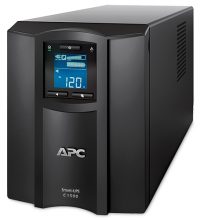 An Uninterruptible Power Supply (or UPS) is a battery backup device for electronic equipment. A UPS provides protection to servers, workstations, network, banking and security systems and other electronic equipment from electrical disturbances. Positioned between the incoming utility power and the electrical equipment connected to it, the UPS filters the power to eliminate any spikes or surges that may cause damage to the computer or the data it is processing. Many UPSs offer a software component that enables you to automate backup and shut down procedures in case there's a power failure
An Uninterruptible Power Supply (or UPS) is a battery backup device for electronic equipment. A UPS provides protection to servers, workstations, network, banking and security systems and other electronic equipment from electrical disturbances. Positioned between the incoming utility power and the electrical equipment connected to it, the UPS filters the power to eliminate any spikes or surges that may cause damage to the computer or the data it is processing. Many UPSs offer a software component that enables you to automate backup and shut down procedures in case there's a power failure
There are two basic types of UPS systems: standby power systems (SPSs) and on-line UPS systems. An SPS monitors the power line and switches to battery power as soon as it detects a problem. The switch to battery, however, can require several milliseconds, during which time the computer is not receiving any power. Standby Power Systems are sometimes called Line-interactive UPSs.
An on-line UPS avoids these momentary power lapses by constantly providing power from its own inverter, even when the power line is functioning properly. In general, on-line UPSs are more expensive than SPSs.
UPS Technologies
 Offline UPS technology is typically found in home use or for powering individual computer workstations and other non-critical applications that only require power outage protection. Offline products sometimes have surge suppression and/or "buck and boost" circuits to compensate for high or low input voltage, but otherwise do not provide any significant input power conditioning.
Offline UPS technology is typically found in home use or for powering individual computer workstations and other non-critical applications that only require power outage protection. Offline products sometimes have surge suppression and/or "buck and boost" circuits to compensate for high or low input voltage, but otherwise do not provide any significant input power conditioning.
 Line-Interactive technology resembles the offline product, but inserts a transformer or capacitors in series between the utility power source and the load. This inline capacitor enables the UPS inverter to "interact" with incoming power and provide some power conditioning to the load. This "buck-and-boost" circuitry helps with high and low input voltage conditions. Commonly used for smaller loads under 5kVA.
Line-Interactive technology resembles the offline product, but inserts a transformer or capacitors in series between the utility power source and the load. This inline capacitor enables the UPS inverter to "interact" with incoming power and provide some power conditioning to the load. This "buck-and-boost" circuitry helps with high and low input voltage conditions. Commonly used for smaller loads under 5kVA.
 On-line technology isolates utility power from your equipment loads. AC power is rectified to DC power to supply the internal DC bus (battery bank) of the UPS. The output inverter takes the DC power and converts it back to computer grade AC power to support the critical load. Batteries attached to the DC bus are float charged during normal operation. When the input power voltage is out of spec, the batteries provide power to support the inverter and critical load. (AC Double Conversion).
On-line technology isolates utility power from your equipment loads. AC power is rectified to DC power to supply the internal DC bus (battery bank) of the UPS. The output inverter takes the DC power and converts it back to computer grade AC power to support the critical load. Batteries attached to the DC bus are float charged during normal operation. When the input power voltage is out of spec, the batteries provide power to support the inverter and critical load. (AC Double Conversion).

 APC
APC Exide Electronics
Exide Electronics Powerware
Powerware Best Power
Best Power Gamatronic
Gamatronic Toshiba
Toshiba Eaton
Eaton Liebert
Liebert Tripp-Lite
Tripp-Lite Emerson
Emerson Mitsubishi
Mitsubishi